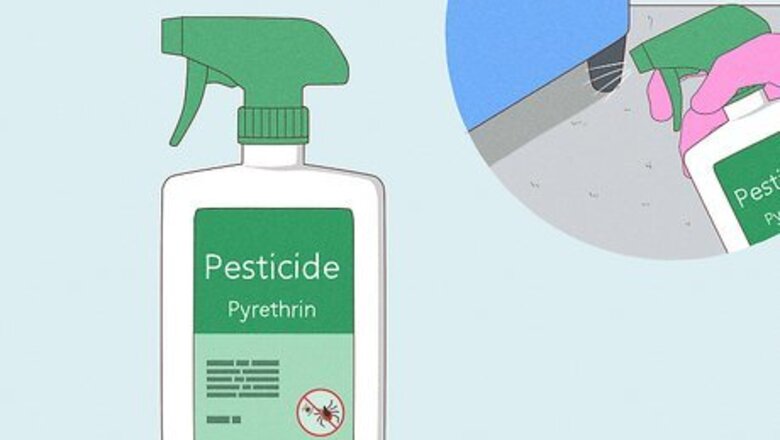
views
- Sprinkle pesticides that contain pyrethrins or permethrins around your home to kill ticks and prevent infestations.
- Use food-grade diatomaceous earth to kill ticks by sprinkling it on your floors, furniture, and in crevices where ticks may lay eggs.
- Spray a mixture of 4 oz (120 ml) of cedar oil concentrate and 26 oz (770 ml) of water directly on ticks and where they’re hiding to kill them.
Getting Rid of Ticks Indoors

Kill ticks with pesticides. Pesticides are going to be your best bet when it comes to killing adult ticks and their larvae. Look for products that contain pyrethrins or permethrins, which are two of the most common insecticides. Be sure to read the label on each product to determine how much to use around your house and whether or not they may be harmful to pets. Apply pesticides thoroughly throughout your home, including on carpets and curtains, and the underside of tables, chairs, and sofas. Read the directions on the pesticide to see if people and animals have to leave the area for a certain amount of time after the pesticide is used.

Use food-grade diatomaceous earth. A natural alternative to chemical pesticides is diatomaceous earth (DE), which is a drying agent that kills ticks. Sprinkle food-grade DE around your home, on furniture, and in small nooks and crannies.
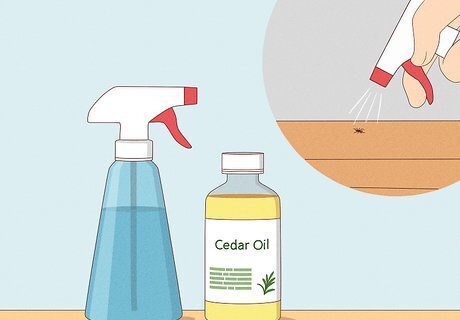
Spray a cedar oil mixture. Mix 4 oz (120 ml) of cedar oil concentrate with 26 oz (770 ml) of water in a spray bottle. Spray the mixture in places where ticks are congregating in your house, or spray the ticks directly when you see them. Just be aware that cedar oil can stain some fabrics. It works especially well on wooden surfaces. The mixture will kill ticks and tick larvae on contact by suffocating them.
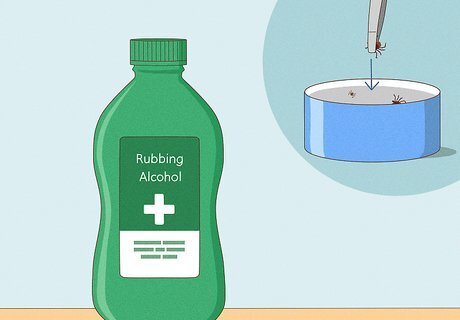
Drop live ticks in a glass filled with rubbing alcohol to kill them. If you find a tick crawling around your house or remove one from yourself, your kids, or your pet, pick it up with a pair of tweezers and drop it into a container filled with rubbing alcohol. Do not pour rubbing alcohol directly on the tick if it’s still biting someone or your pet, as this can make the tick spit out its toxins.

Wash your clothes and bedding in hot water. Unfortunately, ticks like to burrow in your bed just as much as you do, and they can also hitch a ride on your clothes. If you see a tick on your bedding or clothes, wash them with hot water to kill the ticks. Be sure to wash all parts of your bedding if you see a tick there, including your mattress cover, sheets, comforter, and pillowcases. If you notice ticks on your clothing after coming inside from the outdoors, throw them into the dryer on high heat for 10 minutes. The dry heat will kill the ticks. However, if your clothes are wet, throw them in the washer with hot water first before drying. If you suspect any clothes or linens might have ticks, do not put them in the laundry hamper, because this will contaminate the other clothes. Put them straight into the washing machine or dryer.

Remove ticks from pets and treat them with medication. Check your dog or cat when they come inside and physically remove any ticks that are using your animal as a host. Then, talk to your vet about any suggestions they may have for tick prevention treatments. There are also over-the-counter medicines for you to purchase. Look for the ingredients fipronil, pyrethroids, and amitraz, which kill ticks. Note that cats are extremely sensitive to many kinds of chemicals, so consult with your vet before applying any treatments to your cat. The most common places where you’ll find ticks on your pet include around their tail, between their toes, between their back legs, in and around their ears, underneath their collar, under their front legs, and around their eyelids.

Repel ticks with apple cider vinegar, water, and neem oil. Mix together 2 cups (473 ml) of water, 4 tablespoons (59 ml) of apple cider vinegar, and 2 tablespoons (29 ml) of organic neem oil in a spray bottle. Spray this solution on your skin, your clothes, and around your house to repel ticks.

Use essential oils to deter ticks around your home. Eucalyptus oil both repels and kills ticks. Mix 4 oz (118 ml) of purified or distilled water with 20 drops of eucalyptus essential oil in a spray bottle, then spray it on your exposed skin, clothes, or around your house. Other essential oils such as citronella, tea tree, peppermint, almond, jojoba, and neem oil repel ticks as well. Place 1 or 2 drops of neem oil on a tick that’s attached to a person or animal to get it to detach. A study also found that balsam fir essential oil was effective in killing ticks quickly. Add 20 drops of certain aromatherapy essential oils, such as lemon, orange, cinnamon, lavender, or rose geranium, to 4 oz (118 ml) of water and spray it around your house. Ticks don’t enjoy these smells and likely won’t stay around a place that reeks of these scents. Eucalyptus oil is safe to use on dogs only if it has been diluted with water first.

De-clutter your home to remove hiding spots. Ticks like to hide as they wait for an opportunity to latch onto an unsuspecting host. Pick items up from the floor and don’t leave piles of things like dirty laundry, toys, or newspapers laying around. If you have any storage spaces, be sure to keep those well-organized and clean as well.
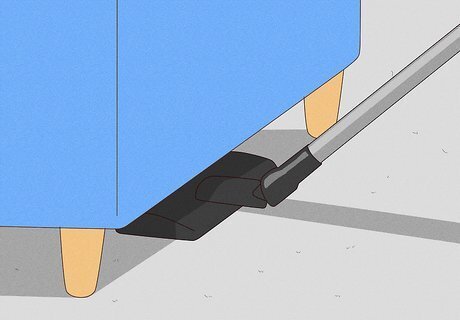
Clean your house thoroughly to get rid of ticks. Do a deep cleaning of your house and make sure to get into every nook and cranny where a tick might be hiding. If you have carpet floors or rugs, get into a routine of vacuuming at least once a week and immediately vacuum up any ticks you see. Sweep and mop your floors, dust your shelves, and seal any cracks or crevices in your walls or floors where ticks can lay eggs. Ticks prefer to be in spots where it’s warm and dry, so pay close attention to spots that may be creating this kind of environment, such as near your heater in the winter. Ticks also usually go for small crevices and tight spaces. Check around your doors and windows, inside the seams of your couch, underneath and behind furniture, and around the baseboards of your walls. Dispose of the vacuum bag immediately after vacuuming up any ticks.
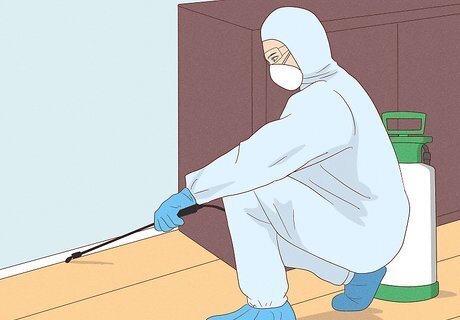
Call an exterminator to deal with a big tick infestation. Severe tick infestations may require a professional exterminator. They have specialized equipment and pesticides, which kill ticks immediately on contact. They also have an in-depth knowledge of ticks' habitats and behaviors, so they’ll be able to locate the ticks very quickly.
Keeping Ticks Out of Your Yard

Use a pesticide around the yard. Check with your local health or agricultural officials to find out when the best time to apply pesticides is, what pesticides to use, and the local rules and regulations about using pesticides. If you do choose to use insecticides, oftentimes just 1 or 2 applications per season will be enough to keep ticks away. Purchase insecticides that have the active ingredients bifenthrin or permethrin. Consider hiring a professional to come and apply pesticides to your yard if you have a lot of ground to cover or if you’re not sure how to properly apply the pesticides.

Cut back vegetation. An important step in keeping ticks away is to get rid of any tick-friendly foliage. The best way to do this is to keep your yard trimmed regularly and remove all dead, scraggly, and overgrown vegetation. Clear tall grasses and brush from your lawn or around your home and cut back any weeds. Ticks prefer to be in humid places. They oftentimes cannot survive in dry conditions. Cutting back tall vegetation will give them less shady and humid places to hide and discourage them from coming into your yard.

Keep your grass short. Regularly mowing your lawn deprives ticks of tall grass to hide in. Consider also using an edger to create a barren zone between your yard and your house that ticks won’t be likely to cross. If you live near a wooded area, place down a 3-foot (0.9 m) barrier of woodchips or gravel between your yard and the woods to discourage ticks from migrating over.

Clear your yard of brush and dead leaves. If ticks can’t live in the grass, they'll find shade elsewhere. Damp, dark brush and dead leaves are like tick heaven. Don't allow piles of vegetation to build up anywhere in your yard. Also, keep ground cover to a minimum to give ticks fewer places to hide. Remove any old furniture, trash, or other debris lying around in your yard as well.
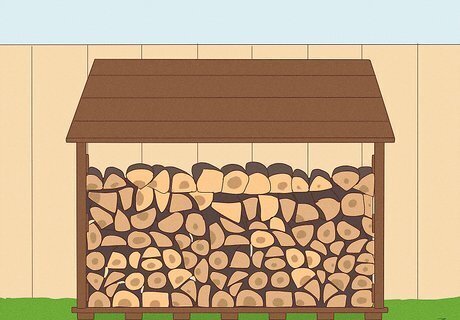
Keep firewood stacked neatly and in a dry location. Like brush and dead leaves, stacks of firewood provide dark, moist environments for ticks to thrive in. Keeping your firewood stacked in a dry location denies ticks of their safe haven, and it will keep your firewood nice and dry for when you use it in the winter. Place your firewood stack away from your house. That way, if there are any ticks, they won’t be able to enter your house easily.
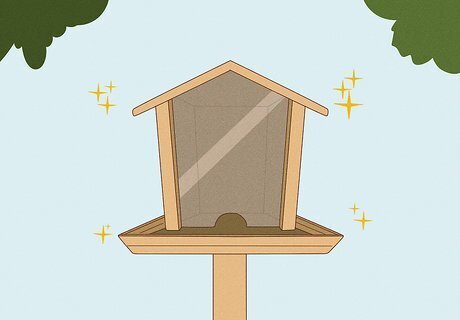
Clean out bird feeders regularly. Spilled birdseed can attract rodents, which may also be carrying ticks. Make sure to clean up any spillages every few days, and also give your bird feeder a thorough cleaning to make sure no ticks are hanging out inside. Clean out any dirt and debris from your feeder by giving it a good shake, then disassemble the feeder and soak the parts in a solution that’s 1 part bleach and 9 parts water. Rinse the bird feeder then let it dry completely before putting it back together.

Fence in your yard to keep out tick-bearing animals. Ticks tend to travel on large animals like deer or coyotes. Putting up a fence around your yard will keep these larger animals out, and it may discourage other smaller tick victims, such as raccoons, from coming in as well. Also, if you have a dog or cat, a fence will help keep them in your yard and away from areas swarming with ticks, such as forests or spots with lots of tall grasses.
Preventing Tick Bites
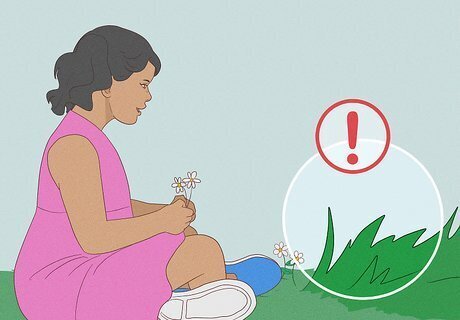
Keep kids away from areas where ticks usually are. If you have kids, make sure they’re playing in areas that are a good distance away from high grasses or dense clumps of trees. If you have any playground equipment that has grass growing around it, get that weed whacker over there and start trimming. Another option is to place things like swing sets and sandboxes on beds of woodchips or mulch instead of grass.
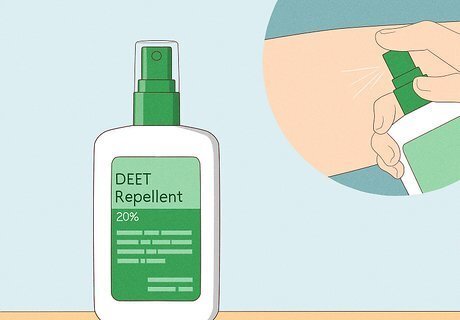
Apply tick repellents to your skin and clothes before going out. Use a repellent that contains at least 20% of DEET, picaridin, or IR3535 on your skin for protection that’ll last up to several hours. Find repellents that contain permethrin to use on your clothes. Avoid getting repellents near your eyes, nose, or mouth. The Environmental Protection Agency (EPA) has an online tool that’ll help you find a repellent that works best for your individual needs.
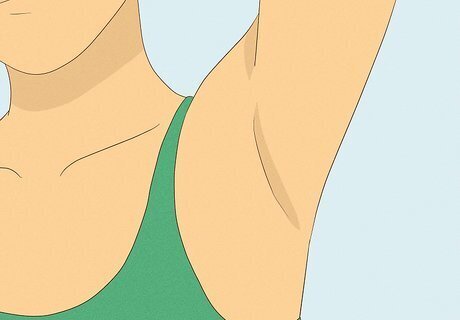
Check yourself and others for ticks. Regularly check yourself, your children, and your pets, especially after playing or hiking outdoors. Check under your arms, behind and inside your ears, behind your knees, and inside your belly button. If you do find a tick, remove it with a pair of tweezers. A tick that’s attached to someone or an animal will look like a brown, black, or reddish-brown oval that sticks out from the skin. Most species of ticks have 8 legs. Wear long sleeves and pants when going outside to prevent ticks from latching onto you. Wear light-colored clothes so you can spot ticks more easily. Tuck your pants into your socks to lessen the chance of ticks getting under your clothes. Take a bath or shower as soon as you enter your house to find ticks faster.


















Comments
0 comment